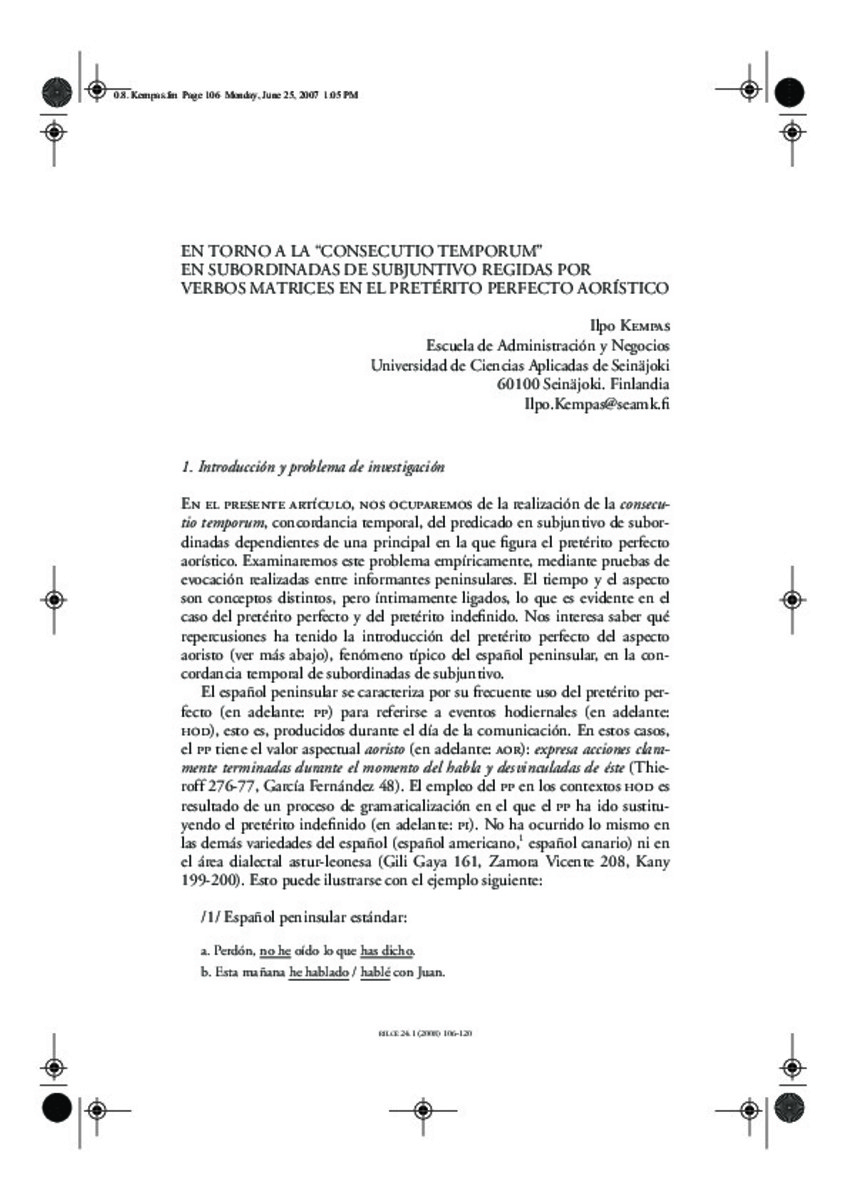Registro completo de metadatos
| Campo DC | Valor | Lengua/Idioma |
|---|---|---|
| dc.creator | Kempas, I. (Ilpo) | |
| dc.date.accessioned | 2010-04-22T15:08:01Z | - |
| dc.date.available | 2010-04-22T15:08:01Z | - |
| dc.date.issued | 2008 | - |
| dc.identifier.citation | Rilce 24.1 (2008): 106-120 | es_ES |
| dc.identifier.issn | 0213-2370 | - |
| dc.identifier.uri | https://hdl.handle.net/10171/6940 | - |
| dc.description.abstract | El artículo trata sobre la concordancia temporal de subordinada de subjuntivo cuando el predicado de la proposición inicial precedente está en el pretérito perfecto (PP) y tiene valor aspectual Aoristo. El PP aorístico aparece con mucha frecuencia en el español peninsular al referirse a eventos ocurridos durante el día de habla. Estudiamos las respuestas de informantes a una prueba de evocación para ver cómo se refleja el valor Aoristo del PP en la elección entre el imperfecto o el presente de subjuntivo. Precedido del PP aorístico en la principal, la subordinada obedece a la temporalidad real del evento de la principal en mayor medida que cuando en ésta figura el pretérito indefinido. Se explica por la ausencia de vínculos asociativos que ligan el pretérito indefinido al imperfecto de subjuntivo y por el modelo que presenta la combinación frecuente del PP del aspecto Perfecto (o ‘Anterior’) con el presente de subjuntivo. The article deals with the sequence of tenses in subjunctive subordinate clauses when the predicate of the preceding principal clause is in “pretérito perfecto” (PP) and aspectually aoristic. Aoristic PP is very commonly used in Peninsular Spanish to refer to events having occurred during the day of utterance. We analyze informant’s answers to an elicitation test to study how the aoristicity of PP is reflected in their choices between the imperfect and the present of subjunctive. When preceded by aoristic PP in the principal clause, the subordinate clause follows the real temporalness of the event of the principal clause to a greater extent than when the predicate of the principal clause is in pretérito indefinido. This can be explained by the absence of associative ties binding pretérito indefinido to the imperfect of subjunctive and by the example set by the frequent combination of PP of the Perfect (or ‘Anterior’) aspect with the present of subjunctive. | es_ES |
| dc.language.iso | spa | es_ES |
| dc.publisher | Servicio de Publicaciones de la Universidad de Navarra | es_ES |
| dc.rights | info:eu-repo/semantics/openAccess | es_ES |
| dc.subject | Consecutio temporum | es_ES |
| dc.subject | Subordinada de subjuntivo | es_ES |
| dc.subject | Aspecto aorístico | es_ES |
| dc.subject | Gramaticalización | es_ES |
| dc.subject | Consecutio temporum | es_ES |
| dc.subject | subjunctive subordinate cluses | es_ES |
| dc.subject | Aorist aspecto | es_ES |
| dc.subject | Grammaticalization | es_ES |
| dc.title | En torno a la consecutio temporum en subordinadas de subjuntivo regidas por verbos matrices en el pretérito perfecto aorístico | es_ES |
| dc.type | info:eu-repo/semantics/article | es_ES |
| dc.identifier.doi | 10.15581/008.24.26340 | es_ES |
Ficheros en este ítem:
Estadísticas e impacto
Los ítems de Dadun están protegidos por copyright, con todos los derechos reservados, a menos que se indique lo contrario.






